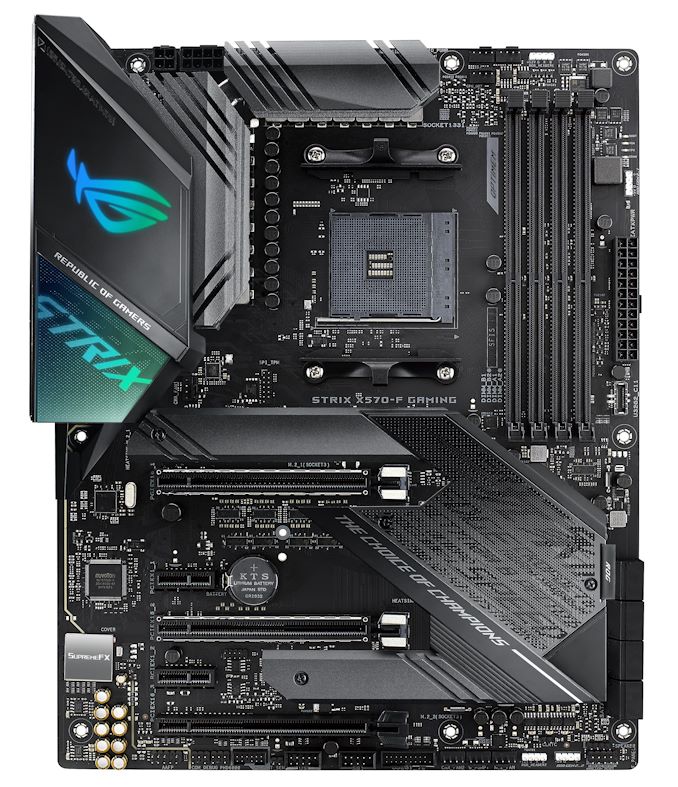The AMD X570 Motherboard Overview: Over 35+ Motherboards Analyzed
by Gavin Bonshor on July 9, 2019 8:00 AM ESTASUS ROG Strix X570-F Gaming
The ASUS ROG Strix X570-F Gaming is the slightly feature slimming ATX sibling of the ROG Strix X570-E Gaming with a very similar aesthetic shared between both models, with fewer premium components and is representative of the mid-range segment of its X570 product stack. The most notable features of the Strix X570-F Gaming include two PCIe 4.0 M.2 slots, eight SATA ports, and an HDMI 2.0b video output on the rear panel. On the design, ASUS has gone with a gaming-inspired which theme of black and grey, with ARGB LEDs implemented into the rear panel cover for a bit of extra flair. The actively cooled X570 chipset heatsink also includes a graffiti-inspired design which fits in with the rest of the board's theme.
On the PCB of the ASUS ROG Strix X570-F Gaming is three full-length PCIe 4.0 ports which are configured to run at x16, x8/x8, and x8/x8/x4. This allows users to run up to two-way NVIDIA SLI and three-way AMD CrossFire multi-graphics card setups. Storage capabilities onboard include two PCIe 4.0 M.2 slots with a pair of M.2 heatsinks which the PCIe 4.0 x4 SSDs are certainly going to appreciate. The board also includes eight SATA ports with support for RAID 0, 1, and 10 arrays. The ASUS ROG Strix X570-F also has four memory slots with the capabilities to run up to 128 GB. Memory support isn't known at present, but more information should be available when this model launches, sometime after 7/7.
The ASUS ROG Strix X570-F uses a single Ethernet port controlled by an Intel I1211-AT Gigabit NIC, while the five 3.5 mm audio jacks and S/PDIF optical output are driven by a SupremeFX S1220 HD audio codec. Looking at rear panel USB, there's three USB 3.1 G2Type-A, one USB 3.1 G2 Type-C, and four USB 3.1 G1 Type-A ports. Also present on the rear panel is a pair of video outputs consisting of a DisplayPort and HDMI 2.0b, with a USB BIOS Flashback button that uses a dedicated USB Type-A port which is clearly highlighted on the IO shield.
Similar to the ASUS ROG X570-E Gaming in terms of stylings, the ROG X570-F Gaming drops some key features to offer users looking for the Strix style, but without the larger hit to the wallet. While a few of ASUS's X570 models are doubled up with Wi-Fi enabled and those without, the Strix-X570-F keeps the core layout, but without the cost-laden features such as Wi-Fi 6, and a 2.5 G NIC. The ASUS ROG Strix X570-F Gaming is almost certainly going to cost less than its better equipped X570-E Gaming sibling, but we currently don't have an MSRP at the time of writing, and this model won't be available at launch.












225 Comments
View All Comments
abufrejoval - Tuesday, July 9, 2019 - link
It's amazing how quickly you run out of PCIe lanes, when you don't have switches to multiplex and translate between PCIe revisions and lanes (e.g. PCIe v4 x2 <-> PCIe v2 x8).I find myself using USB 3.x NBase-T NICs and NVMe adapters, simply because they *do* switch.
Bensam123 - Tuesday, July 9, 2019 - link
Maybe a bit more depth on the power delivery page. I have absolutely no idea how to go about parsing what's there. More chokes is better? What denotes a power phase?A5 - Tuesday, July 9, 2019 - link
+1. Some analysis of that information would be helpful.MrSpadge - Tuesday, July 9, 2019 - link
+1bunkle - Wednesday, July 10, 2019 - link
The controller column includes the total number of phases supported split between CPU cores and SoC e.g. (6+1) = 6 CPU phase and 1 SoC phase. More is *usually* better but has diminishing returns regarding tighter and tighter voltage regulation. Some controllers are better than others (can operate at high frequency e.g. 500KHz v 1000KHz, include other features to improve performance) mitigating the need for more phases.Each phase is a buck converter comprised of a low/high side MOSFET (can be integrated in a single package) and choke. Some controllers can support doubling up the PWM signal to driver more MOSFETs. Doublers can also be added as discrete components if not built into the controller.
Current rating of the MOSFET (e.g. Sic639=40A IR3555=60A) indicates the total power deliverable. MOSFETs are not 100% efficient and vary in efficiency. The more current they provide the hotter they get and the less efficient they become, with better MOSFETs producing less heat for a given current. Thus using doubles can improve temperatures and efficiency without the benefits of the tighter voltage tolerance that *real* phases provide.
Hope that’s helpful!
bunkle - Wednesday, July 10, 2019 - link
A lot more detailed explanation: https://en.wikichip.org/wiki/voltage_regulator_mod...bug77 - Tuesday, July 9, 2019 - link
The description for AsRock X570(M) Pro4 says "5 jack + 1 SPDIF". Unfortunately, those boards lack SPDIF and only come with 3 jacks ;)Smell This - Tuesday, July 9, 2019 - link
I'm thinking the *ASRock Thunderbolt AIC* ...https://thunderbolttechnology.net/product/asrock-t...
would cover all your TBT peripheral needs, including optical.
DanNeely - Tuesday, July 9, 2019 - link
Do X570 boards still need an extra chip per USB port to support USB-C reversibility?The additional expense and needed PCB space were cited as among the reasons why earlier generation boards (IIRC both Intel and AMD) almost never had more than 1 C port; but it was never clear to me if that was an inherent implementation penalty for the C port or an artifact of Intel's tech stack being stalled out and AMD outsourcing to ASMedia which built the chipsets on an ancient (55nm) platform.
DigitalFreak - Tuesday, July 9, 2019 - link
Gavin - X370 and X470 only supported PCIe 2.0. The connection between the CPU and chipset was 3.0, but all the ports on the chipset were 2.0.